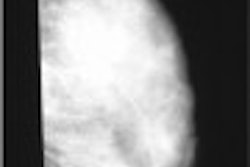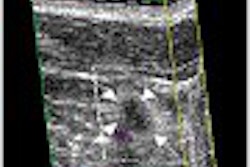Adopting a mobile digital mammography screening service means making a number of complex technical decisions, including the selection of a system with an appropriately sized detector. For high-volume digital screening applications, a 21 x 29-cm image receptor may be the optimal choice, according to researchers from the University of Texas M.D. Anderson Cancer Center in Houston.
"Currently, digital screening mammography is in a development phase and is being road-tested at a couple of sites," said Dr. Gary Whitman. "But identifying the size of the detector that is needed will be helpful for mobile mammography as well as screening mammography at fixed sites."
In evaluating the optimal detector size, the researchers sought to avoid mosaic imaging, which is required when the patient’s breast is bigger than the detector. Mosaic imaging leads to decreased efficiency as well as increased dose, scatter, and imaging time, Whitman said.
"In general, in our current practice we tend to image smaller women with smaller breasts with the digital units," he said. Whitman presented the study team’s research at the 2003 Symposium for Computer Applications in Radiology (SCAR) in Boston.
The detector size also impacts other elements in the digital mammography chain, including how much information can be displayed on a workstation. To determine whether a 19 x 28 cm detector would be feasible for high-volume, mobile digital mammography screening applications, the researchers obtained mobile film-screen mammograms on 322 consecutive women at 15 sites.
The screening group covered a heterogeneous population (including corporate sites, community centers, and county health centers) in a metropolitan area. In 233 cases, images were obtained with a small (18 x 24 cm) image receptor, while 89 were from a large (24 x 30 cm) receptor.
Four measurements were performed in each case: medial-to-lateral (ML), anterior-to-posterior (AP) dimensions on the craniocaudal (CC) view, superior-to-inferior (SI), and the AP dimensions on the mediolateral oblique (MLO) view. The researchers then extrapolated the film-screen measurements to determine the optimal size for a full-field digital mammography detector.
The researchers concluded that 305 cases (95%) could be imaged with a 19 x 27-cm digital receptor. However, a 21 x 29 cm detector with a 2-cm anterior margin and a 1-cm margin at each end would also be practical for that same 95%, Whitman said.
"You’d really like to have a margin of about 1 cm on each end, and probably a centimeter or two anteriorly," he said. "You can’t ask the technologists to do absolute pinpoint-perfect positioning every time. (And) it’s difficult to evaluate skin and superficial tissues if there’s no margin."
In 8% of cases, short axis measurement was greater than 17 cm. The study team also found that in 122 cases (38%), the long axis measurement was greater than 21 cm.
"Thus, with a 2-cm anterior margin and a 1-cm margin at either end, a 19 x 23-cm receptor may not be appropriate for more than one-third of the women in our study population," he said.
However, Whitman said it’s important for each institution to assess the breast sizes of the target population when contemplating the purchase (and location) of a digital mammography unit. Institutions that serve a population with typically smaller-breasted women will have different detector size requirements than those working with women who have larger breasts, Whitman said.
By Erik L. RidleyAuntMinnie.com staff writer
September 9, 2003
Related Reading
CR versus DR -- what are the options?, July 31, 2003
Contrast digital mammography helps visualize cancer in dense breasts, August 29, 2003
MCC finds no additional benefit for digital mammo, June 11, 2003
Shift to full-field digital units will spur mammography market, April 30, 2003
Key variables impact accuracy of digital mammography, April 21, 2003
Copyright © 2003 AuntMinnie.com



















